The first thing you notice about Namibia is that it’s empty, but not luckily its not empty with natural sites and adventures.
With a population of just over 2.5 million people and a landmass of more than 800,000 square kilometers, Namibia is one of the world’s least populated countries with only 2.6 people per square kilometer, that´s not much but still far behind Greenland that only have 0.03 people per square kilometer.

Namibia is a country like nowhere else on earth. The mostly desert landscape with vast stretches of dry, arid terrain looks inhospitable and unremarkable at first, but take a peek beneath the surface, and you’ll discover this Southern African nation has much to offer the visitor.
Surprisingly, Namibia gets only about 1.5 million visitors each year, which is ten times less than its neighbor South Africa.
This may soon change as the world discovers the hidden treasures of this land of endless horizons.
The other-worldly topography of Deadvlei is fodder for Instagrammers and is already one of the most photographed spots on the continent.
But for now, Namibia does not cater to the crowds. And the intrepid traveller who ventures here is rewarded by hypnotic landscapes, an abundant and diverse wildlife, and ancient cultures reminiscent of the history of humankind.
Although it is one of the remotest places on earth, Namibia is well connected with frequent flights between the capital Windhoek and African hubs such as Johannesburg and Addis Ababa.
Through the Middle East with Qatar Airways and from Europe with British Airways, Condor and KLM fly to Namibia.
Here are five reasons to put Namibia on your bucket list:
Has a Surreal Landscape.
The word Namib means “vast place of emptiness” in the local Nama language, and the Namib Desert lives up to its name.
This coastal desert, the oldest in the world, has existed for 55 million years and consists of 80,000 square kilometres of sweeping terrain stretching across South Africa, Namibia, and Angola.
At Sossusvlei in Southern Namibia, sensuous red dunes tower to 400 meters.
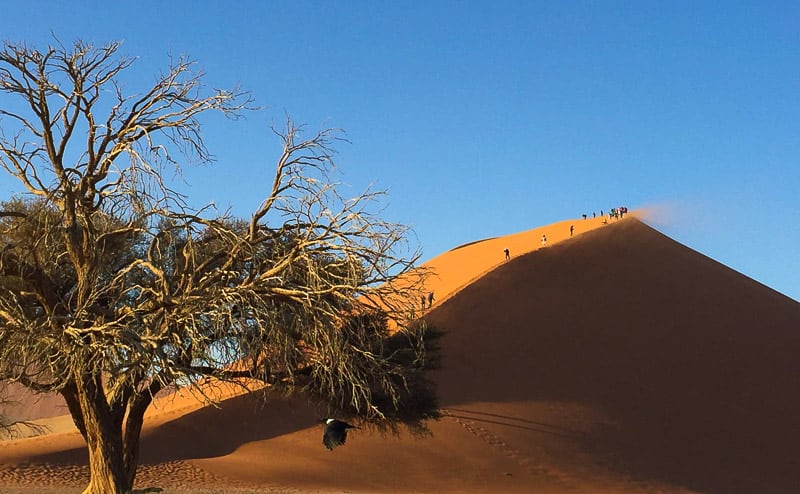
The salt and clay pan, one of Namibia’s most spectacular landmarks, attracts hundreds of visitors, many of whom climb the famous Dune 45 at dawn to see the sunrise over the “sea of sand.”
Located nearby, also in the Namib-Naukluft National Park, is Deadvlei (dead marsh), famous for the characteristic 1000-year-old dark, dead acacia trees that form a striking contrast against the white pan floor, an alien landscape that appears frozen in time and is approachable only by 4x4s.
Also, in the vicinity is Sesriem Canyon, a natural gorge carved a mere 3 million years ago by the mighty Tsauchab River and the site of some stunning rock formations.
Sossusvlei is just over 350 km (200 miles) from Windhoek and is an approximately 5-hour drive on mostly gravel roads, past scenic mountain passes.
Stop en route at Solitaire, a small settlement with a café and the region’s only gasoline station.
Namibia Is Perfect for Soul-Stirring Stargazing.
Virtually non-existent light pollution means Namibia has some of the darkest night skies on earth, which mean a perfect destination for astrophotography.
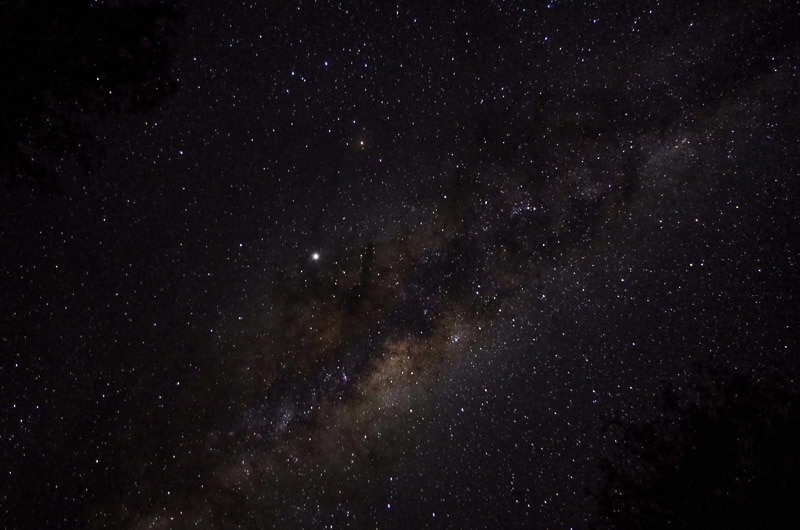
Even without a telescope, stargazers are treated to an astonishing sight of thousands of twinkling stars sprinkled across a velvety black sky.
The Namib Desert is one of the few places in the world where these many constellations are visible to the naked eye.
Besides the vast Milky Way, there’s a chance to see the “big five” of stargazing – the Southern Cross, Jewel Box, Omega Centauri, Tarantula Nebula, and Eta Carinae – clustered around the southern celestial pole and invisible from the northern hemisphere.
The low latitude (Windhoek is 22 degrees south of the Equator) means more than 90% of the celestial sphere is visible.
Professional and amateur astronomers come here to delve into the mysteries of cloudless desert skies and gaze at the brightest, most beautiful constellations in absolute silence.
Parts of the Namib Desert have been recognised for their quality of stargazing with a Gold Tier status by the International Dark Sky Reserve.
The dry winter months are the best time to see the dramatic African skies bedecked with a thousand stars.
Namibia has an Ancient Culture.
The rugged lands of Namibia are some of the most hostile on earth, yet several indigenous tribes have survived here for centuries, preserving their traditional lifestyle.
As some of the only remaining hunter-gatherer societies in the world, the Himba, Herero, and San people fiercely safeguard their culture and rituals.
A member of the San tribe can identify animal dung at a hundred paces and tell you which leaves will cure tuberculosis and which sap will kill you.
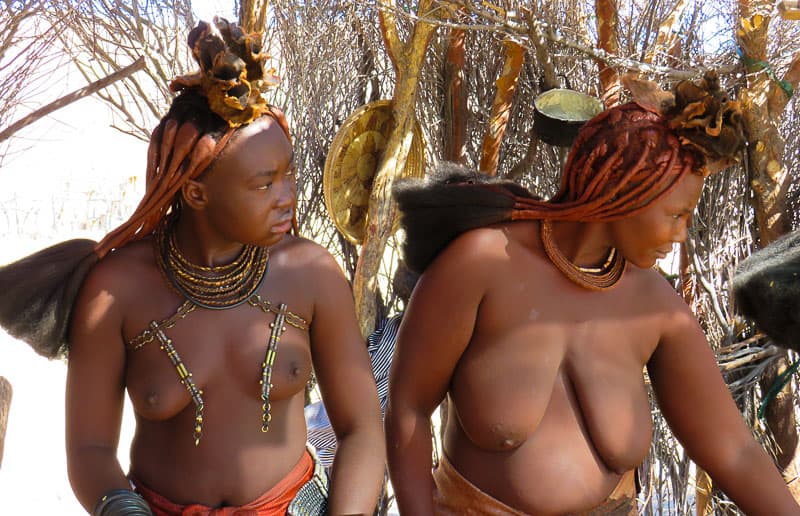
In Herero society, a man’s importance is decided by the number of cattle he owns. Damaraland in Northwest Namibia is home to the Himba tribe whose women use a secret ingredient to keep their skin luminous despite the desert heat and dust. Interacting with Namibia’s tribal people is a chance to gain a fascinating insight into a way of life that is untouched by the modern world.
Namibian cuisine is inspired by the native tribes as well as European settlers. International dishes can be found on most restaurant menus. Game meats, such as crocodile, zebra, kudu, and springbok, are local favourites.
Smoked meats (Rauchfleish) and one-pot bush stews (Potijetos) are must-try specialities.
Namibia Has Incredible Wildlife.
Although less popular than East Africa and South Africa as a safari destination, Namibia’s Etosha National Park offers wildlife enthusiasts a unique game viewing experience.
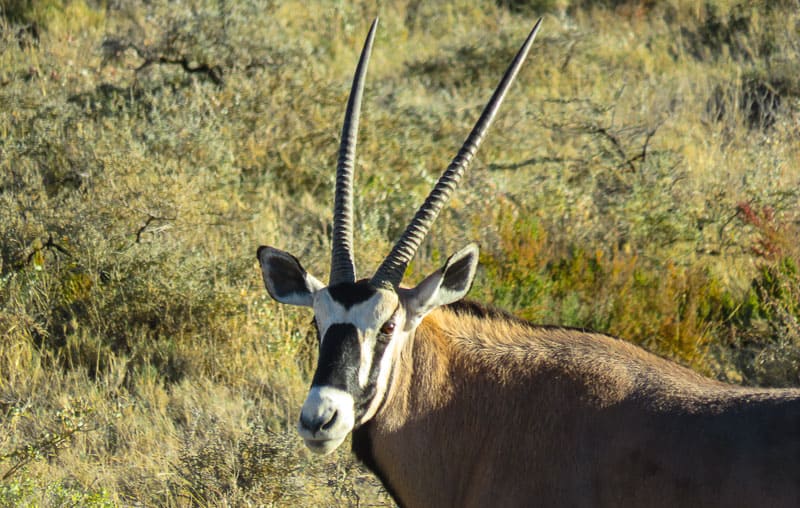
The 22,000-square-kilometer park is home to the single largest population of rhinos in the world. It is also populated by large herds of elephants, zebra, and giraffe as well as more than 100 species of large and small mammals and 400 species of birds.
The desert-adapted wildlife in Namibia has evolved to survive in the harsh and unforgiving environment with distinct physical traits and behaviours that are not seen in neighbouring African countries.
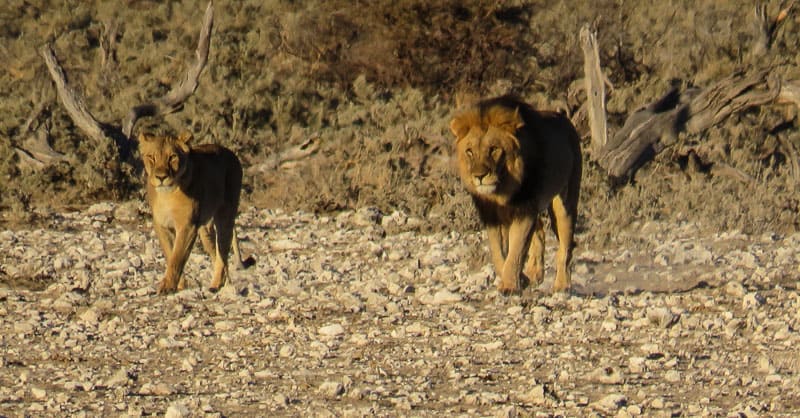
The word Etosha (changed to Etosha by European traders) means “the place where no plants grow.” The arid landscape makes animal spotting easier, and your chances of a thrilling big cat sighting in Etosha are high.
As the sun sets on the savannah, animals gather at watering holes near the various lodges and campsites in Etosha National Park.
The incredible sight of elephants, giraffe, and rhinos silhouetted against a fiery orange African sky is unforgettable. Be sure to check out this post about Elephants in neighbouring Botswana if you are planning a visit there.
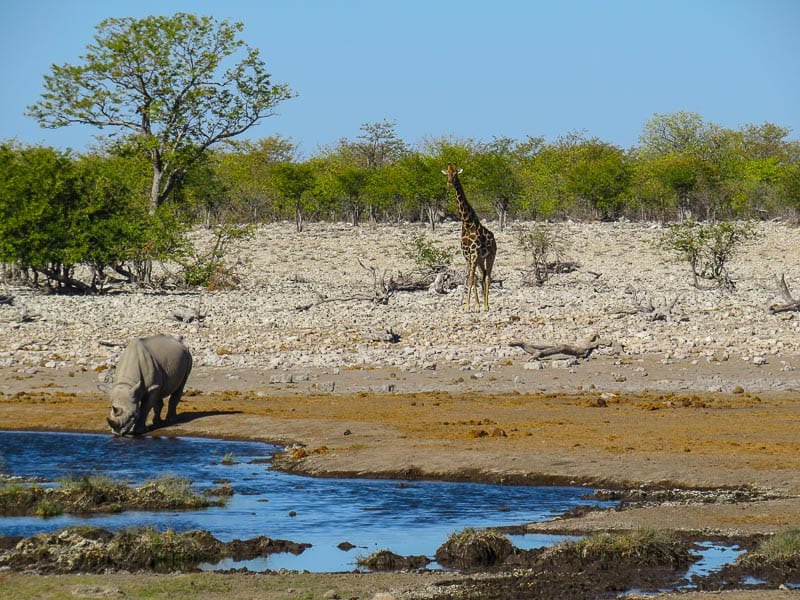
Enjoy a drink or two and marvel at some of the rarest creatures on earth.
Namibia Is A Paradise For A Thrilling Adventure.
Known as the Skeleton Coast in the north of Namibia’s 1000-mile coastline lacks in seaside charm it more than makes up for in compelling, stark beauty.
With most of the shoreline being uninhabited, Swakopmund, on the country’s west coast, is a refreshing break from the bleakness.

This pretty seafront town, sandwiched between the Namib Desert and the Atlantic Ocean, was once a waystation for travellers on African roads and is now Namibia’s adventure capital.
The town is a colonial remnant with a distinctly German flavour, especially in the low season when it feels like a slice of Europe has been transplanted onto African soil.
Visitors flock to the seaside promenades, and adrenaline junkies feed their addiction with quad biking, sandboarding, skydiving, and sea kayaking.
Swakopmund is about 350 km and a 3-hour drive from the capital Windhoek. Visit nearby Walvis Bay (Afrikaans for whale bay), a harbour town famous for its lagoon with plentiful birdlife and a range of recreational activities, restaurants, and accommodation options.
Namibia may not have been part of your plans, but I can promise you, come here once, and you’ll fall in love.
The thrill of visiting one of the most far-flung places on earth is incomparable, and this kind of intimacy with Africa is increasingly rare.
If you are planning a trip to Zambia and the Victoria falls, check out this post about taking a Micro Flight above the largest waterfall in Africa.
Or if you are planning to visit Botswana next, check out these two guides, Chobe National Park and Okavango Delta.
